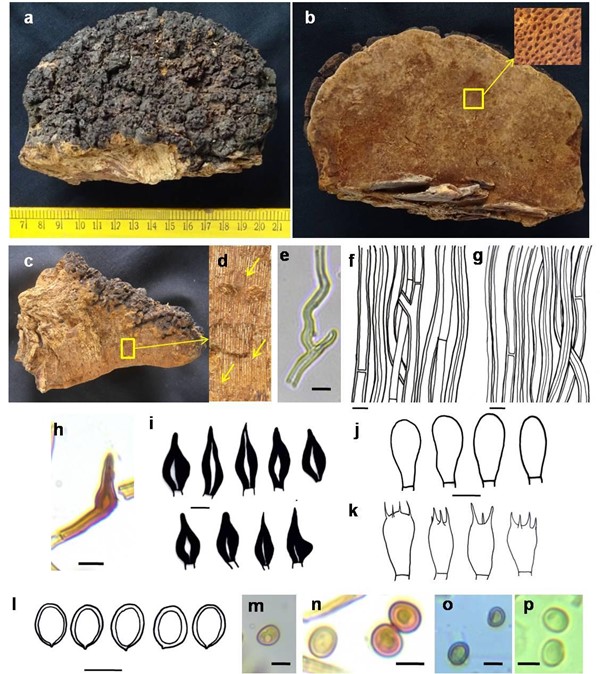Tropicoporus subramaniae Gunaseelan, S., Kaliyaperumal, M. & Kezo, K., sp. nov. (Fig. 1)
MycoBank number: MB 559817; Index Fungorum: IF 559817; Facesoffungi number: FoF 12714
Etymology: The species epithet “subramaniae” referring to the Indian mycologist C. V. Subramanian, for his contributions to the Fungal taxonomic studies in India
Holotype: MUBL4021
Diagnosis: Tropicoporus subramaniae is characterized by sulcate, deeply rimose, irregularly cracked pilear surface, acute margin, homogenous context and stratified tube with monomitic context and dimitic hyphal system in trama, absence of cystidioles and presence of setae and broadly ellipsoid to subglobose basidiospores.
Description: Basidiocarp perennial, solitary, pileate, sessile, woody hard, light in weight when dry. Pileus dimidiate, applanate, ungulate, projecting up to 9.3 cm, 13.7 cm wide and 6.4 cm thick near the attachment. Pilear surface glabrous to sulcate, deeply rimose with irregular cracks, with crust, brownish grey (6F2), greyish brown (6E3) to almost black. Margin entire, acute, golden brown (5D7) to brownish grey (6F2). Pore surface brown (6E7). Pores round to angular, regular, 4–6 per mm. Dissepiments entire, thick. Context homogeneous, up to 0.5 cm, light brown (6D8) to brown (6E8). Tube layer up to 3.7 cm, stratified, each strata up to 0.4 cm thick.
Hyphal system monomitic in the context and dimitic in the tubes, tissue darkening with KOH without swelling; Context Generative hyphae, thin to thick walled, hyaline to golden yellow, simple septate, rarely branched, 2–5.2 μm dia.. Trama Generative hyphae, dominant, thin to thick walled, hyaline to pale yellow, septate, occasionally branched, 2–4.2 μm dia.; Skeletal hyphae, thick walled with narrow to wide lumen, yellowish brown, aseptate, unbranched, 2–4 μm dia. Hymenial setae dark brown, thick walled, ventricose to subulate with a sharp or obtuse tip, 12–28 × 4.5–8 μm. Cystidia and cystidioles absent. Basidia clavate to sub clavate, 8–18.2 × 3.8–6.2 μm, with four sterigmata and a simple septum at the base. Basidioles clavate, 5–16.5 × 3–5.8 μm. Basidiospores broadly ellipsoid to subglobose, thick walled, smooth, yellow in water, turning rust brown in KOH, (5–) 5.3–6.3 (–6.7) × (4.5–) 4.8–5 (–5.2) μm (n = 50/2), Q = 1.2 (Q range 1.1–1.5), CB ̄, IKI ̄.
Specimen examined: INDIA, Tamil Nadu, Thiruvannamalai district, Sathanur, Pennaiyar river, 12º 08’00.34”N 78º 56’48.63”E, on living angiosperm tree (Albizzia amara), 03 Febraury 2018, Sugantha Gunaseelan (Holotype, MUBL4021)
GenBank numbers: ITS: OP003882
Notes: T. subramaniae, has mono˗dimitic hyphal system, deeply and irregularly cracked basidiomes, however, T. angustisulcatus, T. excentrodendri T. lineatus and T. substratificans (Zhou et al. 2015, Wu et al. 2022), differs from our Indian strain in having dimitic hyphal system and uncracked basidiomata.
Despite sharing mono˗dimitc hyphal system and absence of cystidioles, T. flabellatus differs from T. subramaniae by having velutinate to black and brown zones in pilear surface, uncracked basidiomes with smaller pores (7˗9/mm), duplex context with black line, ellipsoidal spores (4.5–5 × 3.5–4 μm), whereas T. subramaniae have sulcate, deeply cracked pilei with larger pores (4˗6/mm), homogenous context and broadly ellipsoid to subglobose basidiospores (5–6.7 × 4.5–5 μm).
T. guanacastensis and T. subramaniae are similar in having sulcate, cracked basidiomata, stratified tube, mono˗dimitic hyphal system, absence of cystidioles and presence of ventricose setae but the former differs in smaller pores (7˗8/mm), ellipsoidal spores (Zhou et al. 2015), while our Indian species have comparatively larger pores (4˗6/mm) and broadly ellipsoid to subglobose spores.
T. subramaniae and T. drechsleri (Salvador˗Montoya et al. 2018), shares concentrically sulcate deeply cracked pilei with mono˗dimitc hyphal system, larger pores (<6/mm) but the South American species varies with indistinctly stratified tube layer, presence of cystidioles and broadly ellipsoid to ellipsoid basidiospores (4–5.5 × 3–4.5 μm), while T. subramaniae have stratified tramal layer without cystidioles and broadly ellipsoid to subglobose basidiospores (5–6.7 × 4.5–5 μm).
Tropicoporus boehmeriae, T. hainanicus, T. minus, T. ravidus, T. stratificans, T. tenuis and T. texanus are having resupinate basidiomata with dimitic hyphal system (Brown et al. 2019, Coelho et al. 2016, Wu et al. 2022), whereas T. subramaniae could be easily distinguished by its pileate basidiomata and mono˗dimtic hyphal system. T. nullisetus lacks setae (Lima et al. 2022), which is different from other reported Tropicoporus species and with Indian T. subramaniae, varies with other morpho˗microscopical characters.

Fig.1 Tropicoporus subramaniae Microscopic structures of Tropicoporus subramaniae a Basidiomata (Holotype). b Pore surface. c Cross-section of basidiome. d Stratified tube layer. e branched generative hyphae from context. f Contextual hyphae. g Tramal hyphae. h-j Hymenial setae. k Basidioles. l Basidia. m-q Basidiospores: m Basidiopore in water. n Basidiopore in KOH. o Basidiopore in cotton blue. p Basidiopore in Melzer’s reagent. Scale bar: e-p = 5 μm
